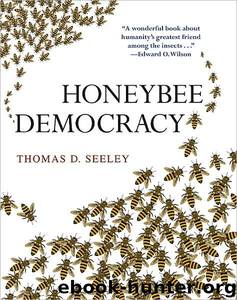Honeybee Democracy by Thomas D. Seeley

Author:Thomas D. Seeley
Language: eng
Format: mobi, azw3, epub
Tags: Science, Non-fiction
ISBN: 9780691147215
Publisher: Princeton University Press
Published: 2010-09-20T10:00:00+00:00
Heinrich discovered many marvelous things about temperature regulation in honeybee swarms, all of which are key to understanding how a swarm prepares to fly to its new home. First, he found that a swarm does indeed precisely control the temperature of the cluster’s core so that it stays at 34–36°C (93–97°F) regardless of the ambient temperature. He also found that a swarm allows the temperature of the cluster’s mantle (outer layer) to vary with the ambient temperature, but that it keeps the mantle temperature above 17°C (63°F) even if the ambient temperature falls to freezing (0°C or 32°F). This means that the outermost bees, which are the coolest, keep themselves warm enough to stay active on the swarm. If they were to cool below 15°C (59°F) they would enter “chill torpor” and easily fall from the swarm. They would also be too cold to warm themselves back up by shivering.
When Heinrich looked at how the bees achieve their characteristic pattern of temperatures in a swarm, he found that they do so without expending much of their on-board energy supply, that is, the honey in their stomachs. At air temperatures above about 10°C (50°F), the resting metabolism of a swarm—the metabolism that occurs when the flight muscles of the swarm bees are not being ac-tivated—provides more than enough heat to keep a swarm’s core at 35°C and its mantle above 17°C. Indeed, at high ambient temperatures (above about 20°C or 76°F), the resting metabolism produces so much heat that both the mantle bees and the core bees spread themselves out, creating ventilation channels to release excess heat from the core. But when the ambient temperature falls below 17°C, and the mantle bees start to feel too cool, they crowd inward, causing the swarm cluster to shrink, its porosity to decrease, and its heat loss to diminish (figs observa 7.2 and 7.3). In this way the mantle bees skillfully trap inside the swarm cluster the metabolic heat generated by the thousands of resting, immobile bees, and they also keep themselves sufficiently warm. It is only when the air temperature falls below about 10°C (50°F) that the mantle bees must take the extra step of raising their metabolic rate by shivering.
Thus Heinrich discovered that the bees in a honeybee swarm have an effec-tive means of conserving their energy reserves. The mantle bees, those most exposed to low temperatures, minimize their need for active metabolism by doing two things when the air becomes cool: (1) letting their body temperatures drop to just above the chill-torpor temperature rather than working to maintain a higher body temperature, and (2) keeping their body temperatures above the chill-torpor temperature mainly by huddling rather than shivering. Of course, these energy conservation measures mean that most of the time the outermost bees in a swarm are too cold to fly, something that is easily demonstrated by skimming a spoonful of mantle bees from a swarm and shaking them into the air. The bees tumble to the ground rather than fly away.
Download
Honeybee Democracy by Thomas D. Seeley.azw3
Honeybee Democracy by Thomas D. Seeley.epub
This site does not store any files on its server. We only index and link to content provided by other sites. Please contact the content providers to delete copyright contents if any and email us, we'll remove relevant links or contents immediately.
Sapiens: A Brief History of Humankind by Yuval Noah Harari(14319)
The Tidewater Tales by John Barth(12625)
Mastermind: How to Think Like Sherlock Holmes by Maria Konnikova(7278)
Do No Harm Stories of Life, Death and Brain Surgery by Henry Marsh(6905)
The Thirst by Nesbo Jo(6877)
Why We Sleep: Unlocking the Power of Sleep and Dreams by Matthew Walker(6654)
Life 3.0: Being Human in the Age of Artificial Intelligence by Tegmark Max(5513)
Sapiens by Yuval Noah Harari(5322)
The Longevity Diet by Valter Longo(5040)
The Body: A Guide for Occupants by Bill Bryson(5027)
The Rules Do Not Apply by Ariel Levy(4910)
The Immortal Life of Henrietta Lacks by Rebecca Skloot(4548)
Animal Frequency by Melissa Alvarez(4425)
Why We Sleep by Matthew Walker(4394)
The Hacking of the American Mind by Robert H. Lustig(4338)
Yoga Anatomy by Kaminoff Leslie(4332)
All Creatures Great and Small by James Herriot(4269)
Double Down (Diary of a Wimpy Kid Book 11) by Jeff Kinney(4240)
Embedded Programming with Modern C++ Cookbook by Igor Viarheichyk(4141)
